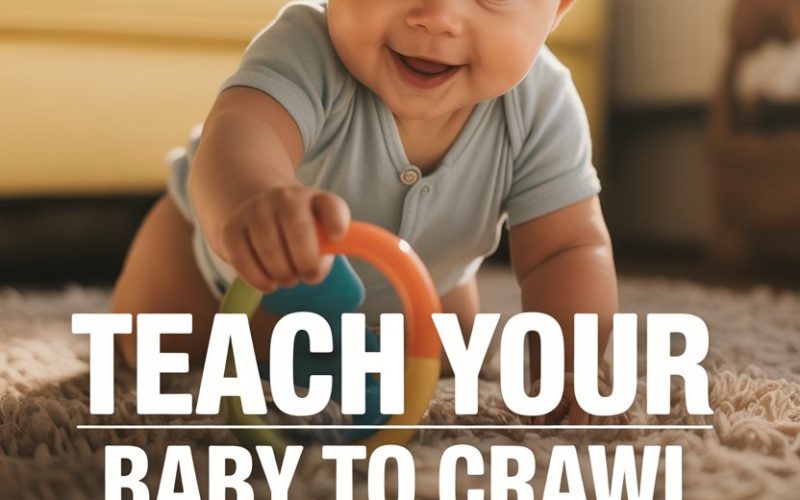If your little one has mastered the art of rolling across the living room like a pint‑sized steamroller, you might be wondering when the real ground‑level action starts—crawling.
There’s something magical (and let’s be honest, slightly nerve‑wracking) about watching a baby set off on all fours for the first time.
Crawling isn’t just a milestone to capture for the grandparents; it’s a key moment in your child’s physical and cognitive development.
And if you’re a busy parent, you’ll be relieved to know that you don’t need a fancy program or an extra hour in the day to encourage it—just a little intention and perhaps a sense of humour when your baby decides to crawl straight for the dog’s water bowl.
Why Crawling Matters (Even If Your Baby Would Rather Scoot)
Crawling does a lot more than give your baby a ticket to the Tupperware drawer. This stage helps build muscle strength, coordination, and even supports brain development by encouraging left‑right movement.
According to the experts at HealthyChildren.org, crawling helps babies practice visual tracking, spatial awareness and hand‑eye coordination.
Not every baby crawls in the textbook way, and some skip the stage entirely, but that doesn’t mean you can’t give yours a nudge (figuratively, not literally) in the right direction.
Create a Baby‑Friendly Floor Space
No surprise here: babies are more likely to crawl where they feel safe and comfortable.
Clear a section of carpet or use a soft play mat—something that cushions those chubby knees and wrists. If you’ve got hardwood or tiles, a mat is essential.
Tidy away any Lego bits and rogue raisins (parents are natural archaeologists when it comes to floor debris). Place a couple of soft cushions or rolled‑up towels around the edge as a “bumper” to keep your baby on course.
A clutter‑free space means fewer distractions, fewer bumps, and—most importantly—fewer “what’s‑that‑in‑your‑mouth?” moments.
Let Those Toes and Fingers Wiggle
Bare feet and hands give your baby the confidence and grip they need. Socks are adorable, but they can turn your baby into a miniature ice‑skater.
Ditch them for playtime. Clothing that’s too tight or restrictive will only cause frustration and might hinder movement.
Pick comfy, stretchy outfits—and if you’re home and the heating’s on, a nappy and a vest will do nicely. Yes, chunky thighs look even cuter exposed.
Tummy Time: The Unsung Hero
Tummy time isn’t just a rite of passage for Instagram feeds. This activity strengthens the neck, shoulders, arms and core muscles—all crucial for crawling.
Start with short periods several times a day, even as little as two minutes if your baby is a protester.
If your baby squawks the moment their tummy hits the mat, try getting down on their level and chatting or singing. Prop a colourful toy or an unbreakable mirror in front of them.
According to the NHS, tummy time is essential for building the muscles that babies need to roll, sit and crawl.
Be patient—no one likes to plank when they’d rather be cuddled.
Use Toys as Motivation—But Not Too Many
Babies are cunning. If they see something interesting slightly out of reach, they’ll try to get to it. Place a favourite toy, a soft ball, or even your phone (they know what’s precious to you) just beyond fingertip range.
Don’t cover the play zone with every toy in the house. Too many distractions can be overwhelming and may halt efforts to move forward—literally.
Rotate which toys you use. Today it’s the jingling giraffe, tomorrow the crinkly book. Watch how your baby responds and adjust as needed.
If a toy isn’t doing the trick, sometimes your smiling face is all the motivation they need.
Get Down on the Floor Yourself
No one likes to feel alone in their efforts. Lie on your tummy across from your baby, make silly faces, and encourage them to come toward you.
Sometimes, just seeing you at their level is enough to spark a new wave of determination.
You can also demonstrate crawling yourself. Feel free to ham it up—you’re not auditioning for the Royal Ballet, after all. Movement is contagious, and babies love to imitate.
Even siblings or other caregivers can get in on the act. A crawling “race” can be hilarious and surprisingly effective.
Encourage the Mini Milestones
Before babies get around to the classic crawl, they might rock back and forth on hands and knees, pivot in circles, or do an impressive backward shuffle. These wobbly attempts are all steps in the right direction.
Acknowledge and cheer on each effort (yes, even when they reverse into a wall). Applause and smiles go a long way toward keeping motivation high.
And if your baby is more of a commando crawler—dragging themselves along by their arms while their legs trail behind—take it as part of the process. Every baby has a signature move.
Skip the Baby Walkers and Jumpers
It’s tempting to stick a frustrated baby in a walker or jumper to “help them get moving.” The truth is, these gadgets can actually delay crawling and even walking by supporting your little one’s weight in the wrong way.
The American Academy of Pediatrics recommends steering clear of walkers entirely, as they’re not only unhelpful but can also be dangerous.
Floor play is where the magic happens. Your baby’s muscles will thank you, and you’ll save space (and money) on gear that just gathers dust.
Embrace Short, Frequent Play Sessions
Babies have the attention span of a goldfish on a sugar rush. Rather than trying to set aside an hour for “crawling practice,” sprinkle short sessions throughout the day. Five or ten minutes here and there is plenty.
After a nap or a nappy change, pop your baby on the floor for a wriggle. Keep these times fun and low‑pressure. If your baby gets fussy, it’s a cue to pick them up and try again later.
No need to build a strict schedule—just work crawling opportunities into your everyday routine.
Spot Signs Your Baby’s Ready to Try Crawling
- Pushing up on arms during tummy time
- Rocking back and forth on hands and knees
- Pivoting in circles or rolling across the room
- Reaching out for toys and trying to pull forward
If your baby isn’t showing much interest by about nine months, check in with your health visitor or GP—it’s rarely a reason to panic, but a quick chat can offer reassurance.
Make Safety the Star of the Show
If you thought your home was baby‑proofed, crawling will prove you wrong. Suddenly, every electrical socket, dangling cord and dust bunny becomes a point of interest.
- Cover outlets and secure loose cords
- Move small objects out of reach
- Use safety gates at stairs
- Secure heavy furniture to the wall
And never underestimate how quickly a determined crawler can move—your morning cuppa may never be safe again.
Celebrate Progress (And Be Ready for Surprises)
Crawling is a process, not a competition. Some babies start as early as six months, others wait until ten months or later. A few bum‑shuffle or roll about and never properly crawl at all.
Celebrate every wobbly inch forward. Take too many videos. Text the grandparents. Just don’t panic if your baby chooses their own timetable.
And brace yourself: the moment your little one figures out they can crawl, the days of sitting still are officially over.
When All Else Fails, Trust Your Baby
Every baby develops at their own pace. Some are cautious, some are thrill‑seekers. Your role is to create a safe, encouraging space and let them figure out the rest—preferably without eating the houseplant.
If you’re concerned, or if your baby seems to have trouble supporting their weight or using both sides of their body, a friendly word with your health visitor or paediatrician will set your mind at ease.
Most of the time, things progress just as they should.
The Next Chapter: From Crawling to…Everything!
Once your baby sets off on their hands and knees, you’ll notice other skills blossoming almost overnight. Sitting up, pulling to stand, cruising along furniture—it all starts from that first determined crawl.
Before you know it, you’ll be wishing you could go back to the days when putting your child down meant they’d stay in one spot.
Enjoy the adventure. And maybe invest in a good pair of running shoes.





